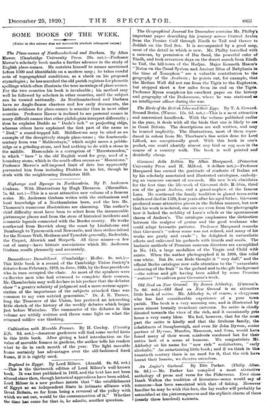SOME BOORS OF THE WEEK.
Wanes in this column dose not rsecesaarfly Fnrscwrc rs8usqaeN. Mg.WI
The Place-names of Northumberland and Durham. By Allan Mawer. (Cambridge University Press. 20s. net.)—Professor Mawer's scholarly book marks a further advance in the study of English place-names. Ho restricts himself to names mentioned before 1500 and identifiable on a modern map ; he takes careful note of topographical conditions, as a check on his proposed etymologies ; he has searched the old parish registers for phonetic spellings which often illustrate the true meanings of place-names. For the two counties his book is invaluable ; his method may well be followed by scholars in other counties, until the subject can be treated nationally. Ae Northumberland and Durham have no Anglo-Saxon charters and few early documents, the historic evidence for place-names is scantier than in most other counties. Professor Mawer is inclined to see personal names in many difficult names that other philologists interpret differently ; thus he explains Duddo as " Duda's hoh " or projecting ridge, whereas others have explained the first part of the name as " Dod," a round-topped hill. Middlestone may be cited as an example of the deceptively simple place-name ; the fourteenth- century form was " Malderstayn," which might mean a pebble- ridge or a grinding-stone, and had nothing to do with a stone in the middle. Hassendale is a corruption of " Hare.stanesden," in which hare " is the old English word for grey, used of a boundary stone, which in the south often occurs as " Hoarstone." Professor Mawer's self-imposed limit of date has apparently prevented him from including Flodden in his list, though he deals with the neighbouring Bankston Hill.


































 Previous page
Previous page